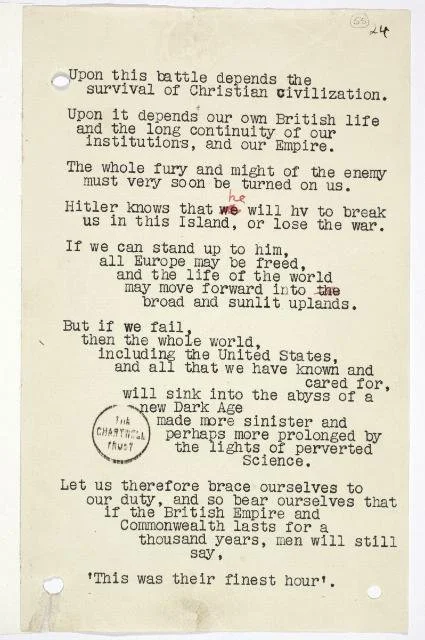Speak like Churchill
Churchill: Man | Orator
18 June 1940, Winston Churchill is but weeks into his role as Prime Minister, in arguably one of recent history’s most tumultuous times. At 3:49PM he launches the most powerful weapon in his arsenal which galvanises both a nation and an empire.
There’s no doubt Churchill himself is a complex and polarising character. His brashness, stubbornness, questionable opinions on colonialism, and any other number of character flaws are well documented in books the size of howitzer shells.
Like any well-minted Churchill commemorative coin though, he has more than one side, so rather than focus on how he lived, today we are focusing on how he spoke. While few of us are likely to ever deliver speeches of the same magnitude as Churchill, there’s no less value in applying some of his oratory skills to our own speeches and presentations.
Make it a symphony
Churchill once said a speech is much like a symphony. It may have three movements but must have one dominant melody.
What is the underlying thought or action we’re wanting our audience to leave with? Once our dominant melody is clear, the movements (being our arguments / data / updates) will easily follow.
In his Presenting to Win course, Tony Bulmer reminds us this applies even in an Information Briefing - and can be as direct as something like “I don’t want you to do anything, I’m not looking for any approvals - I just want you to walk out of here confident we’re on track with our [current strategy / sales projections / tunnelling progress / etc.]”
Churchill wanted his audience to walk away confident that despite the grim future which lay ahead, the challenges and grief they were about to endure, their duty and resolve would become a thing of legend.
At almost 36 minutes long, Churchill’s Finest Hour speech had many movements, but only one dominant, and unforgettable melody.
Even Churchill’s typed notes are set out like a songbook
Hit like a hammer
Speaking at his former school, Churchill’s speech in October 1941 was yet again focused on duty and sacrifice. Although easier to fit on a souvenir tea-towel or mug, the famous lines of “Never give in” are followed by even more repetition - the striking of the hammer.
“If you have an important point to make, don’t try to be subtle or clever. Use a pile driver. Hit the point once. Then come back and hit it again. Then hit it a third time - a tremendous whack.”
and……….[pause]
Listening to any of Churchill’s most influential speeches is a free lesson in the power of the pause. Detractors often claim pausing will lose an audience or make us appear unsure or lost.
The exact opposite is true.
Other than conversing with an overexcited 11-year-old, conversations are not a constant barrage of words, a blitzkrieg of sound. We take natural pauses; for moments of reflection and consideration, and at the same time giving people time to digest what we’ve said.
If we’re wanting audiences in our formal presentations or briefings to hear the sweet sounds of our hammer strikes amongst the melody, perhaps we can give them a moment or two to enjoy them along the way.
The list of ways in which we can learn from the maestro is long, but one thing Churchill also championed was brevity.
If you’ve enjoyed this post, sign up to our Mailing List to get all the latest updates, news and access to free resources.


